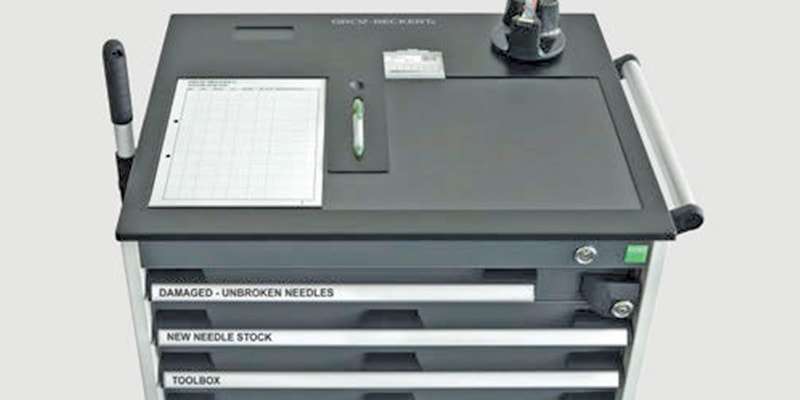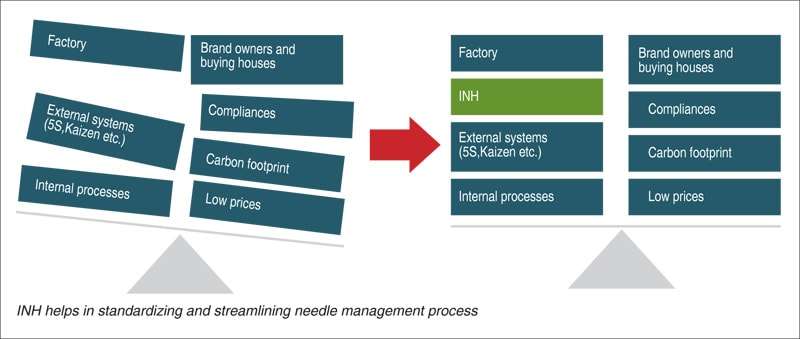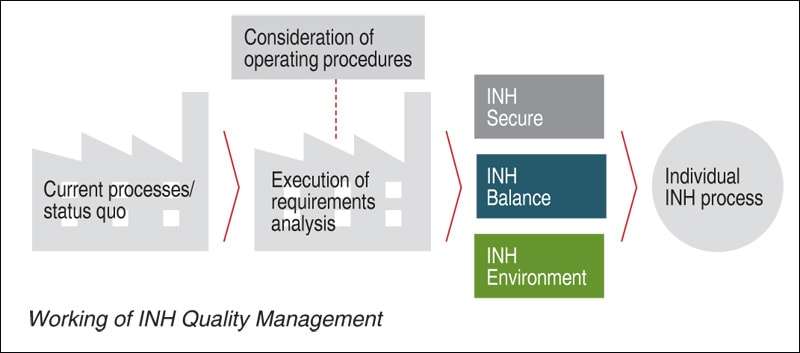
The sewing floor of any apparel facility face a number of challenges such as productivity increase with demands of high output; minimal proportion of waste and rejections; reduced machine downtime; occupational health and safety; different environmental aspects like smallest possible footprint required and recycling of materials; and adoption of lean production, 5S or Kaizen. Alongside are the ever-stricter regulations obligated by brand owners and buying houses relating to the handling of sewing machine needles. None other than Groz-Beckert, a premier supplier of comprehensive and high-quality sewing needles, offers a standard process for the handling of broken and damaged needles on the shopfloor. Ron Russell, Groz-Beckert, USA shares on how the company is also a partner to their customers before, during and after the production process also.

Difference of regulations regarding sewing machine needles varies from brand owners, buying houses as well as countries. International brand owners and buying houses impose strict regulations related to handling of needles, with the intention of making clear that it is critical that no parts of a broken needle remain in the garment, in order to avoid compensation claims from subsequent end-consumers of sewn products. Non-cohesive regulations highlight the need of a uniform standard for sewing machines handling. Furthermore, different practices for needle exchange, needle storage and needle disposal, and thorough search of needle fragments results in production bottlenecks and requires excessive time and effort. Born out of such experiences gathered from numerous sewing plants and brand owners, INH (Ideal Needle Handling) ensures a trouble-free, time saving handling of broken and damaged sewing machine needles. The patented INH process supports all the aspects such as handling of needles, occupational safety, environment and productivity. It offers the individual creation of a process which takes into account all previous operating procedures. Along with ensuring best possible care of sewing personnel with the determined handling of broken needles and optimum ergonomically designed working equipment, the quality management also ensures sewing needles leaving the factory complete and in a condition capable of being recycled, thus minimizing the carbon footprint. INH reduces the amount of time and work involved in dealing with broken and damaged needles, hence higher work performance due to fewer production downtimes. Developed in keeping with the 5S and Lean Production Method, and with elements of Kaizen, in particular the different types of waste (Muda), INH is based on another Muda: unused expertise. How INH works?

INH defines the process for handling of sewing machine needles in sewing plants right from needle storage, issuing needles for production, procedure used for needle exchange to the event of needle breakage. In this way, a cohesive process is shaped for the entire history of a needle from its entry into the company through the documentation of needle breakage to the point at which it leaves the factory in a recyclable condition. It closes the gap between existing processes and regulations to be adhered to. Three defined application stages are applicable: INH Balance (finding the right balance between all requirements), INH Secure (secure the existing) and INH Environment (strive for maximum protection of the environment). A team of qualified trainers remain involved in the analysis of all related divisions within the factory, hence logging and integrating the individual requirements of the respective company. Analysis of existing value stream in the factory
When the existing procedure regarding broken and damaged needle handling is analysed at the factory, the common practice there is a central needle exchange station in the factory where the sewing operator carries the used needles/part of broken needles to the exchange station. Such system could lead to the loss of needle parts. The sewing operator stands in a line at the exchange station to get a new needle. If the operator is unable to present all the needle fragments, he would return to his workstation to find the missing parts. If the missing pieces of needle cannot be located, procedures of arduous searching, documentation and approval procedures are followed, which ultimately results in long downtimes at the production time as the operator will be busy in searching. This type of situation depicts the irregular capacity utilization at the needle exchange station. Generating the new value stream in cooperation with the factory and brand owner/buying house After the introduction of INH in the factory, a significant change could be observed in the needle handling procedure, better than the chaos in the case above. The needle exchange station is replaced by a mobile INH trolley. When the needle exchange person is notified, he/she moves to the machine. The search for the needle fragments begins at the same time. The advantage of INH trolley is that the operator does not have to leave his workstation. He can safely deposit the needle fragments and determine whether the needle is complete or not. The trolley offers leaner searching, documentation and approval procedures.
Selection of required accessories
Groz-Beckert also provides the necessary accessories designed specifically for INH Quality Management which comply with the highest standards of quality, are designed for maximum ergonomics, conform to the principles of a 5S workstation and form the basis for the “needle change’’ work cycle in compliance with Lean. Trolley It is the centrepiece of INH that replaces the entire needle exchange station. It is used for the storage of new needles and various tools, and as collection point for used/broken needles. Worktop The black worktop with recessed work areas for the documentation of sheets is suitable for right- and left-handed users and for all customary paper sizes. It also offers space for a writing tool i.e. a pen or a pencil. It also features a chute for damaged needles through which the used needles can be posted in the acrylic container for collecting used needles in the top drawer. The worktop also has a freely fixable dispenser for adhesive tape. Present on the side of the trolley is a magnetic broom with a very strong magnet to pick up the needle pieces on the floor. A slight twist of the handle deactivates the broom in order to drop the broken metal parts. With this range of functions, the worktop functions as a “depot” for needle transfer.
Storage of unused needles
The storage area for new needles is arranged nicely for quick retrieval. The separate closing system ensures maximum safety. Tools Tray There is also a tools tray used for the storage of tools for the execution of INH processes and for the mechanics as well. The foam can be individually tailored for additional tools. Hanging Folder The hanging folder is designed for the storage and documentation of broken needles. In addition, there is a collecting container for empty needle packs in this drawer. Needle Storage Sheets The needle storage sheets are used to stick on and store broken needles and for documentation purposes. Up to 10 needles can be stored on the needle sheet. The date and time of needle breakage, the machine number, line and machine operator as well as the number of needle fragments can be recorded in seven columns. The fragments are pasted on in the last column. Collecting bin in the INH trolley Made of acrylic, a container is placed besides the hanging folder which is used to collect empty packages. Needle return box
The needle return box is used for the collection and return of broken and damaged needles. The inserted needle log contains all the relevant data required for documentation. The length of the slot for the broken needle is calibrated to compare with total needle length and quickly estimate if all broken parts are collected or not. While the low strength magnetism keep the needle parts securely at the slot, a cello tape can very quickly help transfer the broken parts from the needle box to the needle storage sheets. The intelligent ergonomic design helps the needle pasting in storage sheets to be very quick, neat and complete. Collecting cylinder
The collecting cylinder facilitates a secure disposal of used needles outside the trolley. It is firmly shut at the top by a lid which, depending on the model, has a suitable posting slot for needles or empty packages. The cylinders are also ideally suitable for placing in a clearly visible location to denote application of the quality management system. Conclusion While INH helps an organization in standardizing and streamlining the needle management process, some loose ends need to be tied to make it a technologically superior and sustainable process. The pen-paper documentation still leaves scope for manual error. To facilitate the documentation, the company is currently working on an electronic system, so that there is a technical storage channel to document the movement of needles and quantity of needles per needle system, so that it sends a system for ordering or re-ordering needles and replenishing them. The disposal of broken/damaged needle is currently in the hands of the manufacturing organization. A sustainable and responsible recycling system is the need of the hour to take INH to new height.

Post a Comment